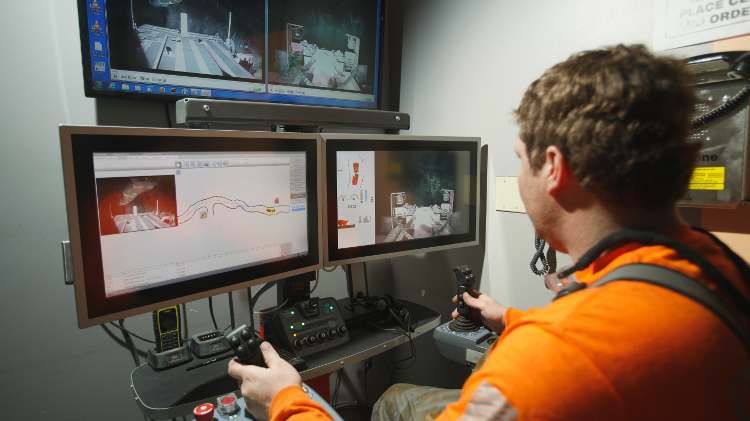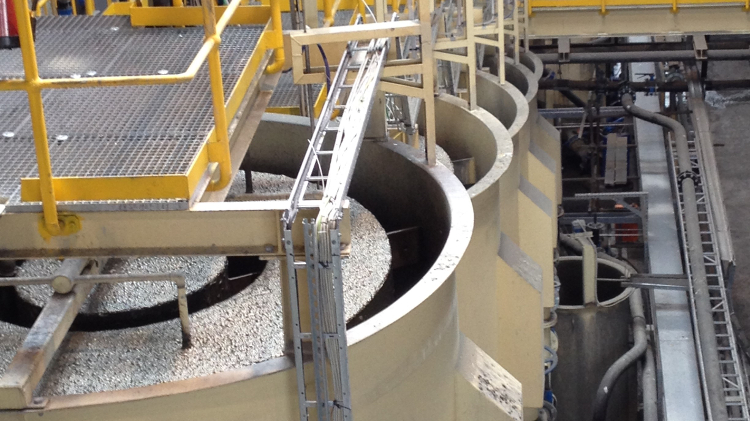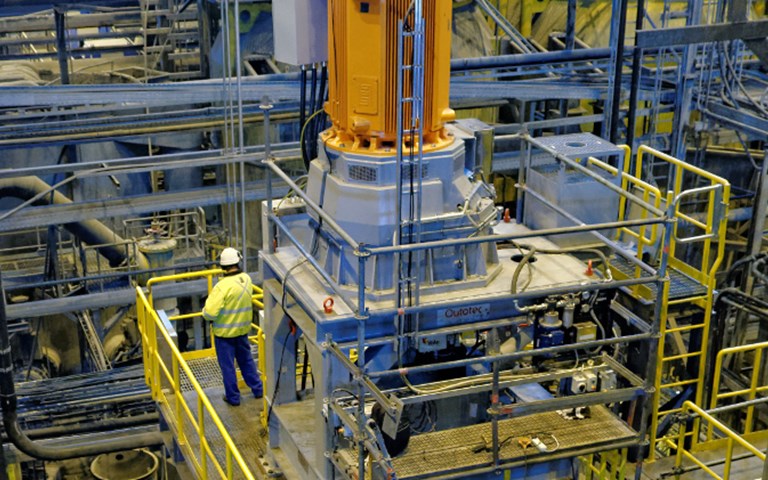The grinding discs and small ceramic beads in Outotec’s tall, narrow HIGmill improved the copper recovery rate at First Quantum Minerals’ Kevitsa operation by one per cent. Courtesy of Outotec
First Quantum Minerals (FQM) has improved copper recovery and concentrate grade quality at its Kevitsa mine by installing a vertical stirred mill provided by Outotec. It is one of the first hard-rock mines to use the High-Intensity Grinding Mill (HIGmill), which has previously seen use in the industrial minerals industry.
The HIGmill’s rotating grinding discs stir small ceramic beads, which wear down ore particles to a size where even very fine grained minerals can be liberated. The tall, narrow shape of the mill and the configuration of its discs produce a very efficient grind, according to Steve Schmidt, Outotec’s commercial product manager for HIGmills.
Kevitsa’s chief metallurgist, Ishmael Muzinda, said the mill’s installation had increased throughput, produced higher-purity copper and nickel concentrates, and led to a slight increase in overall copper recovery. “With everything considered, it means we put the regrind mill-payback to under two years, if not a year,” he said.
Fine grain problematic for flotation
Kevitsa, a copper-nickel-platinum operation in Finland, started up commercial production in 2012 with throughputs of five million tonnes per year. The original flowsheet involved grinding in two AG mills and a secondary pebble mill, sequential copper flotation and then nickel flotation in order to produce two separate concentrates.
However, about 12 per cent of the copper was not recovered during the copper flotation stage because of poor liberation and grade-recovery constraints. “If the liberation is poor, then you don’t get a good copper-nickel separation,” said Muzinda. “And that copper that is reporting to the nickel concentrate is not paid for at the same rate as copper in copper.”
Mineral liberation analysis showed that the main minerals of interest, chalcopyrite and pentlandite, were finely disseminated in the ore, and the grain size was very small, sometimes as low as 15 microns. “Because of the issue of copper-nickel separation, we identified the need to regrind to 20 microns,” said Muzinda.
HIGmill design
The HIGmill represents Outotec’s entry into a field opened by Xstrata with the IsaMill and occupied by Metso and FLSmidth, among others. The concept of a stirred mill originated with white mineral processing, and the HIGmill has more than 200 installations in that industry. In 2012, Outotec acquired exclusive rights to mining applications from the Swiss manufacturer STM Minerals.
Stirred mills use attrition-type grinding, which wears away the surface of ore particles instead of breaking them. The HIGmill is one of a few vertical designs that let gravity do the work of compacting the grinding media and promoting efficient contacts between media and ore slurry.
In the HIGmill, 70 per cent of the shell is filled with ceramic grinding media three to four millimetres in size. A rotating vertical shaft is fitted with discs that stir the media. When slurry is pumped from the bottom, it travels through the grinding discs to the top of the mill, wearing finer and finer through contact with the media. Counter-discs attached to the shell liner block particles from bypassing the grinding discs, while holes in the discs let the finest particles pass through without further attrition.
The most obvious difference between the HIGmill and its competitors is its tall, narrow aspect ratio, unique agitator design and the existence of the stationary counter-discs. According to Schmidt, that effectively creates a plug flow reactor that makes it “virtually impossible to short-circuit particles through the mill.”
HIGmill installed at Kevitsa
In February 2015, FQM added a regrinding stage to its copper concentrator. Copper rougher concentrate is fed to the HIGmill, which regrinds it and passes it on to the copper cleaner in an open circuit.
FQM considered other ball and stirred mills for its regrind stage. Muzinda said that some options were struck from the list because they used steel grinding media, which could alter the pulp chemistry of the ore and cause gangue to float. Others had too large installation costs, operating costs or footprints. At only about a metre in diameter, the 700-kilowatt Outotec model installed at Kevitsa was small enough to fit into the concentrator layout without much difficulty.
Importantly, Outotec also offered a complete solution with automated controls. “We were willing to be the first hard-rock mine to test this technology because we saw the benefits of it having some inbuilt control capabilities,” said Muzinda. The mill’s variable speed drive can be adjusted in response to the quantity or nature of the feed. At Kevitsa, an online particle size analyzer – the Outotec PSI 500 – measures the product from the regrinding circuit. If the primary grind output becomes finer, the HIGmill slows its motor and does not waste energy on overgrinding the minerals.
Learning curve
Immediately upon commercial installation, it turned out that the 20 micron target grind size could be adjusted upward: 30 to 35 microns would achieve the targeted flotation performance.
However, the grinding discs wore down very fast. “Initially we were having to change the grinding discs every four weeks,” said Muzinda. FQM and Outotec have been reducing disc wear by trying out different shapes and metal alloys. The current discs are expected to last four to six months; continuing optimization work seeks to bring that even further.
“This will be followed by further work on the ceramic grinding media,” said Muzinda. “This, if it is successful, will also prolong the life of the grinding discs.”
“For me it wasn’t particularly surprising that we didn’t get the exact material specification we wanted to initially,” said Schmidt. “And there was always going to be some learning experiences for the hard rock application. One of the really positive findings we’ve had at Kevitsa is that there’s been virtually no wear at all on the shell liner, which is a significant positive for the technology.”
The bottom line
Most importantly, FQM has achieved its goal of improving recovery. The amount of copper reporting to nickel has dropped from 12 per cent to eight per cent. Overall copper recovery has increased by one per cent.
If concentrate prices alone were paying back FQM’s investment in the HIGmill, it would take several years. But Muzinda remarked that the regrind stage allows the feed for flotation to come in at a slightly coarser grind: 70 per cent passing 75 microns. Before HIG installation, anything below 75 per cent passing was considered too coarse.
“That then benefits throughput,” said Muzinda. With increased throughput factored in, he estimated payback at under two years.
A spreading technology
The installation at Kevitsa seems likely to be the first of many. Schmidt pointed out that as worldwide ore quality drops, regrinding is becoming a more critical stage. Ten other Outotec HIGmills are in the engineering or deliverable stage at other copper and platinum projects. Schmidt said he expects the data stream from Kevitsa to aid in marketing this technology to mining customers.
He stressed, however, that the technology had already been proven in flowsheets almost identical to a typical mining operation. The basic design has not changed.
Could there be other comminution tools out there, waiting to be discovered? “I’m sure there are technologies that could cross over to the mining industry,” said Schmidt. Caution is understandable, he added. “I just think the mining industry itself needs to be a little more proactive in extending new technologies from other industries.”




